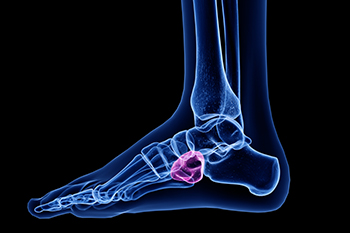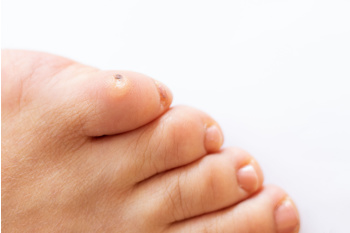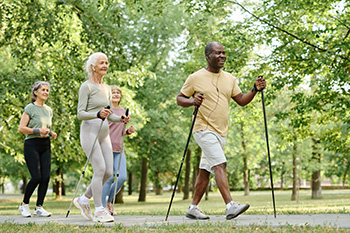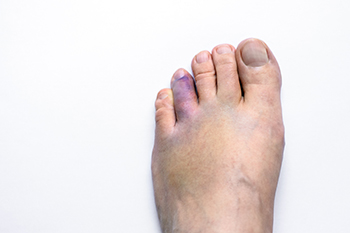Items filtered by date: August 2025
Heel Pain in the Morning?
The Cuboid Bone and Cuboid Syndrome

The cuboid bone is a small, cube-shaped bone on the outer side of the foot between the heel bone and the 4th and 5th metatarsal. It helps provide stability and supports weight during movement. Cuboid syndrome occurs when this bone becomes partially dislocated or misaligned, leading to pain and difficulty walking. Symptoms include aching on the outer foot, swelling, and reduced range of motion. Causes can involve overuse, ankle sprains, improper footwear, or repetitive strain. Risk factors include flat feet, high arches, and participation in sports with sudden directional changes. A podiatrist can diagnose cuboid syndrome, realign the bone, provide supportive taping, and recommend a change in footwear or custom orthotics. If you have persistent outer foot pain, it is suggested that you consult a podiatrist who can accurately diagnose and treat what might be going on.
Cuboid syndrome, also known as cuboid subluxation, occurs when the joints and ligaments near the cuboid bone in the foot become torn. If you have cuboid syndrome, consult with Brain Middleton, DPM from Medical Foot Care Center. Our doctor will assess your condition and provide you with quality foot and ankle treatment.
Cuboid syndrome is a common cause of lateral foot pain, which is pain on the outside of the foot. The condition may happen suddenly due to an ankle sprain, or it may develop slowly overtime from repetitive tension through the bone and surrounding structures.
Causes
The most common causes of cuboid syndrome include:
- Injury – The most common cause of this ailment is an ankle sprain.
- Repetitive Strain – Tension placed through the peroneus longus muscle from repetitive activities such as jumping and running may cause excessive traction on the bone causing it to sublux.
- Altered Foot Biomechanics – Most people suffering from cuboid subluxation have flat feet.
Symptoms
A common symptom of cuboid syndrome is pain along the outside of the foot which can be felt in the ankle and toes. This pain may create walking difficulties and may cause those with the condition to walk with a limp.
Diagnosis
Diagnosis of cuboid syndrome is often difficult, and it is often misdiagnosed. X-rays, MRIs and CT scans often fail to properly show the cuboid subluxation. Although there isn’t a specific test used to diagnose cuboid syndrome, your podiatrist will usually check if pain is felt while pressing firmly on the cuboid bone of your foot.
Treatment
Just as the range of causes varies widely, so do treatments. Some more common treatments are ice therapy, rest, exercise, taping, and orthotics.
If you have any questions, please feel free to contact our office located in Rome, GA . We offer the newest diagnostic and treatment technologies for all your foot care needs.
Causes and Risk Factors of Corns

Corns are thickened areas of skin, known as keratotic lesions, that often on the toes or soles of the feet form due to friction or pressure. They develop as a protective response to ongoing irritation from wearing tight footwear, abnormal foot structure, or repeated movement. Risk factors include foot deformities, improper shoe fit, or prolonged walking or standing. Corns may appear as hard, dry areas, soft corns between the toes, or seed corns on the bottom of the foot. They can become painful and interfere with daily activities. A podiatrist can identify the type and cause of corns and provide safe, effective treatment. If you have developed a painful corn, it is suggested that you consult a podiatrist who can provide effective relief and prevention tips.
If you have any concerns regarding your feet and ankles, contact Brain Middleton, DPM of Medical Foot Care Center. Our doctor will treat your foot and ankle needs.
Corns: What Are They? and How Do You Get Rid of Them?
Corns can be described as areas of the skin that have thickened to the point of becoming painful or irritating. They are often layers and layers of the skin that have become dry and rough, and are normally smaller than calluses.
Ways to Prevent Corns
There are many ways to get rid of painful corns such as wearing:
- Well-fitting socks
- Comfortable shoes that are not tight around your foot
- Shoes that offer support
Treating Corns
Treatment of corns involves removing the dead skin that has built up in the specific area of the foot. Consult with Our doctor to determine the best treatment option for your case of corns.
If you have any questions, please feel free to contact our office located in Rome, GA . We offer the newest diagnostic and treatment technologies for all your foot care needs.
Changes in Foot and Ankle Function With Age

As the body ages, the structure and function of the feet and ankles begin to shift. Natural wear and tear, along with a lifetime of activity, can lead to decreased flexibility, weaker muscles, and thinning of the protective fat pads that cushion each step. Joint cartilage may become worn, and ligaments may lose some of their elasticity, making balance and movement less steady. These changes can affect posture, walking patterns, and stability. Even small changes in foot shape or ankle strength can increase the risk of falls or discomfort. Wearing supportive footwear, regular movement, and attention to foot health can help maintain mobility. If walking becomes more difficult or foot pain increases with age, it is suggested that you consult a podiatrist to address these concerns and improve comfort during daily activities.
If you have any concerns about your feet, contact Brain Middleton, DPM from Medical Foot Care Center. Our doctor can provide the care you need to keep you pain-free and on your feet.
Biomechanics in Podiatry
Podiatric biomechanics is a particular sector of specialty podiatry with licensed practitioners who are trained to diagnose and treat conditions affecting the foot, ankle and lower leg. Biomechanics deals with the forces that act against the body, causing an interference with the biological structures. It focuses on the movement of the ankle, the foot and the forces that interact with them.
A History of Biomechanics
- Biomechanics dates back to the BC era in Egypt where evidence of professional foot care has been recorded.
- In 1974, biomechanics gained a higher profile from the studies of Merton Root, who claimed that by changing or controlling the forces between the ankle and the foot, corrections or conditions could be implemented to gain strength and coordination in the area.
Modern technological improvements are based on past theories and therapeutic processes that provide a better understanding of podiatric concepts for biomechanics. Computers can provide accurate information about the forces and patterns of the feet and lower legs.
Understanding biomechanics of the feet can help improve and eliminate pain, stopping further stress to the foot.
If you have any questions please feel free to contact our office located in Rome, GA . We offer the newest diagnostic and treatment technologies for all your foot and ankle needs.
Types of Broken Toes

Broken toes can range from simple cracks in the bone to more severe fractures that involve joint displacement or multiple bone fragments. These injuries often result from sudden trauma, such as dropping a heavy object on the foot or forcefully striking a hard surface. Common symptoms include sharp pain, swelling, bruising, and difficulty walking, especially if pressure on the affected toe causes discomfort. A toe that appears crooked or shortened compared to its neighbors may indicate a displaced fracture or dislocation. A podiatrist will typically perform a thorough foot exam and may use X-rays to confirm the type and severity of the fracture. If the bone is misaligned or severely broken, surgery may be needed to restore proper toe position and prevent long-term complications. If you have broken a toe, it is suggested that you make an appointment with a podiatrist for an exam and suggested treatment options.
A broken toe can be very painful and lead to complications if not properly fixed. If you have any concerns about your feet, contact Brain Middleton, DPM from Medical Foot Care Center. Our doctor will treat your foot and ankle needs.
What to Know About a Broken Toe
Although most people try to avoid foot trauma such as banging, stubbing, or dropping heavy objects on their feet, the unfortunate fact is that it is a common occurrence. Given the fact that toes are positioned in front of the feet, they typically sustain the brunt of such trauma. When trauma occurs to a toe, the result can be a painful break (fracture).
Symptoms of a Broken Toe
- Throbbing pain
- Swelling
- Bruising on the skin and toenail
- The inability to move the toe
- Toe appears crooked or disfigured
- Tingling or numbness in the toe
Generally, it is best to stay off of the injured toe with the affected foot elevated.
Severe toe fractures may be treated with a splint, cast, and in some cases, minor surgery. Due to its position and the pressure it endures with daily activity, future complications can occur if the big toe is not properly treated.
If you have any questions, please feel free to contact our office located in Rome, GA . We offer the newest diagnostic and treatment technologies for all your foot care needs.


